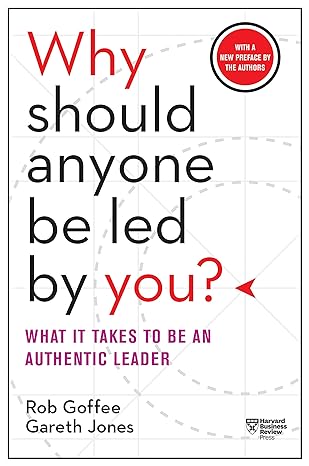
Why Should Anyone Be Led by You? What It Takes to Be an Authentic Leader - by Rob Goffee & Gareth Jones
Date read: 2017-11-19How strongly I recommend it: 8/10
(See my list of 150+ books, for more.)
Go to the Amazon page for details and reviews.
Good read for managers just starting out in leadership. A good balance of the importance of having high EI but also the need to separate yourself from your team and to not be afraid to show them your weaknesses.
Contents:
My Notes
The underlying assumption is that leadership is something we do to other people. But in our view, leadership should be seen as something we do with other people. Leadership must always be viewed as a relationship between the leader and the led.
There are no universal leadership characterstics. What works for one leader will not work for another. You need to identify and deploy your own personal leadership assets.
Three fundamental axioms about leadership:
- Situational - What is required of the leader will always be influenced by the situation. Through their interactions, effective leaders construct alternative contexts to those which they initially inherited. They use their personal leadership assets to reframe situations - to the benefit of those they lead.
- Nonhierarchical - Great organizations have leaders at all levels. They seek to build leadership capability widely and to give people the opportunity to exercise it.
- Relational - You cannot be a leader without followers.
The four elements followers want from leaders are:
- Authenticity
- Significance
- Excitement
- Community
Leadership should not be judged by its popularity but by its effectiveness.
Your colleagues have a simple but basic need: they want to be led by a person, not by a coporate apparatchik.
The challenge for all inspiring leaders is to become more knowing and more skilled at disclosing themselves, rather than trying to become someone else.
Leaders convey the reassuring message that "if you fall, I will catch you." Their people know the leader has the strengths to carry out the task but that he will also step aside and let them develop their own strengths.
Effective leaders pursue a clear and simple strategy: they try things out and get feedback.
Seek out new experiences and new contexts.
Get honest feedback.
Leaders are there to give people what they need rather than what they want. They communicate through tough empathy that balances respect for the individual, the task at hand, and, ultimately, the higher purpose.
Unless you are clear about your purpose and your values and are doing something that you really care about, it is difficult to act as a leader.
Skillful leaders are realists. THey have a well-developed sense of what can be changed - and what cannot. They understand the real conditions in which they must operate, and work within those constraints.
Three elements to effective situation sensing:
- Observational and cognitive skills. Leaders see and sense what's going on in their organizations - and then use their cognitive skills to interpret these observations.
- Behavioral and adaptive skills. Having observed and understood the situation, effective leaders adjust their behaviors.
- Leaders use their own behavior to change the situation. THey exemplify an alternative context.
It is very important that the leader doesn't just pick up one clue and deduce a complete model of an individual's motives from it. Rather, they are constantly building up and adjusting their understanding of the key people around them.
Try to work backward from what they are good at and augment what they have.
Leaders with remote teams should first establish face-to-face relationships. Once this has been established, then relationships can be maintained by other means.
Leaders must conform enough if they are to make the connections necessary to deliver change.
Leaders now need distance to establish perspective, to see the big things that may shape the future of the organization, and closeness, to know what is really going on inside their business.
Leadership isn't necessarily about standing with the troops in the trenches. Sometimes you have to be up on a hill, surveying the whole field.
Be distant when you tell them what to do; be close when you talk about how.
The four elements followers want from leaders are:
- Authenticity
- Significance - Ask yourself these questions: Do you pay the same kind of attention to those that you wish to lead? Do you make them feel that what they are trying to achieve is important, and that they themselves have a vital role to play?
- Excitement
- Community